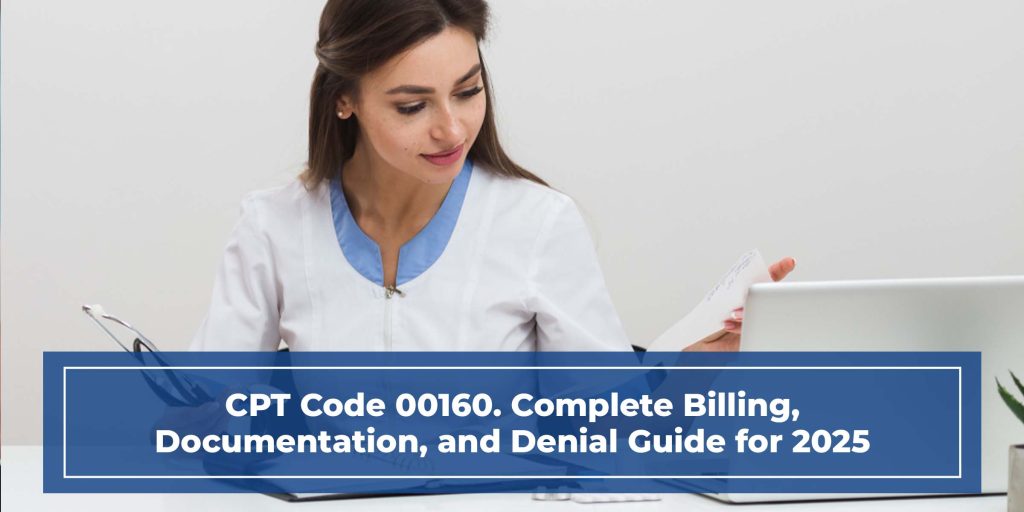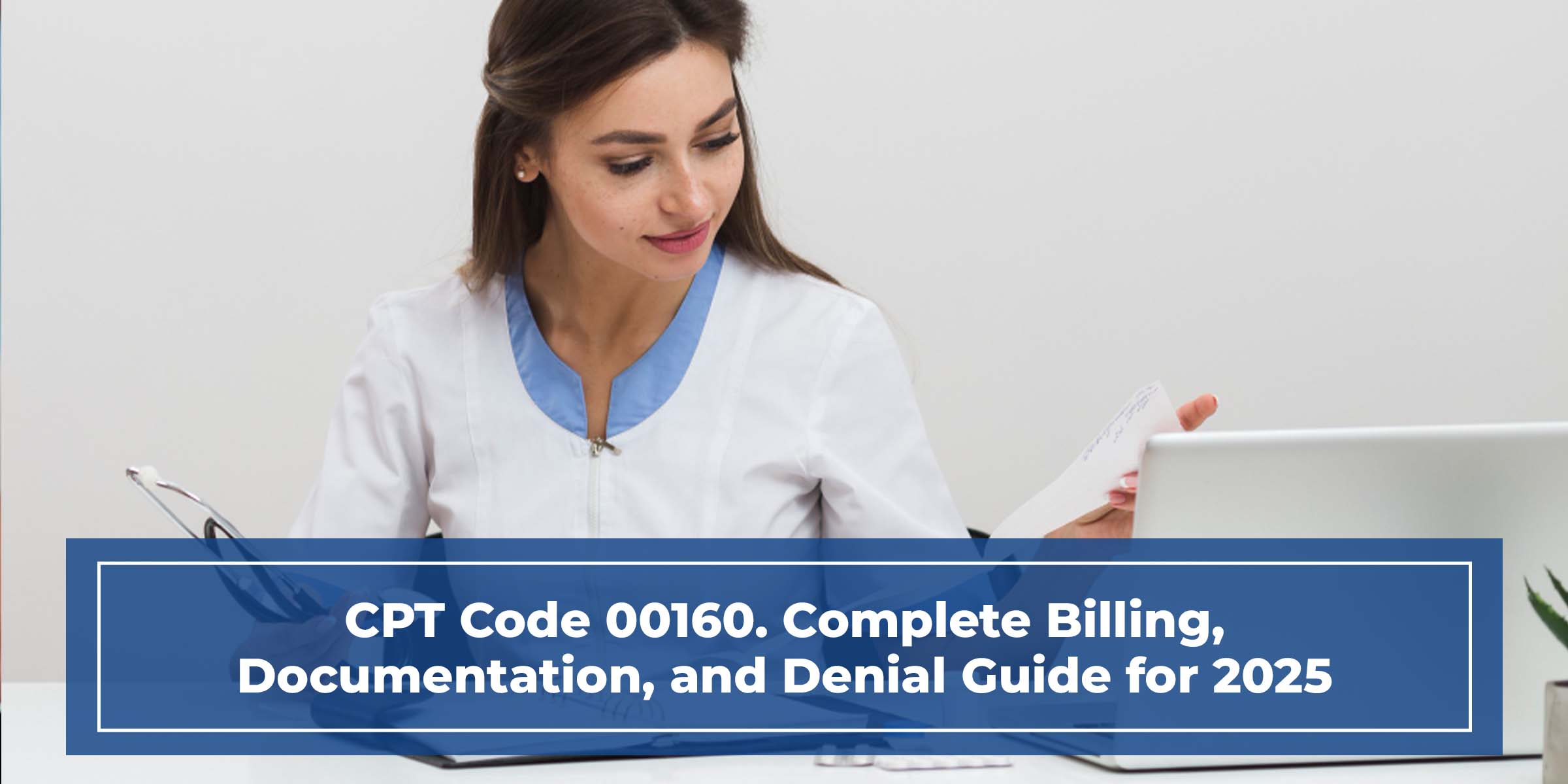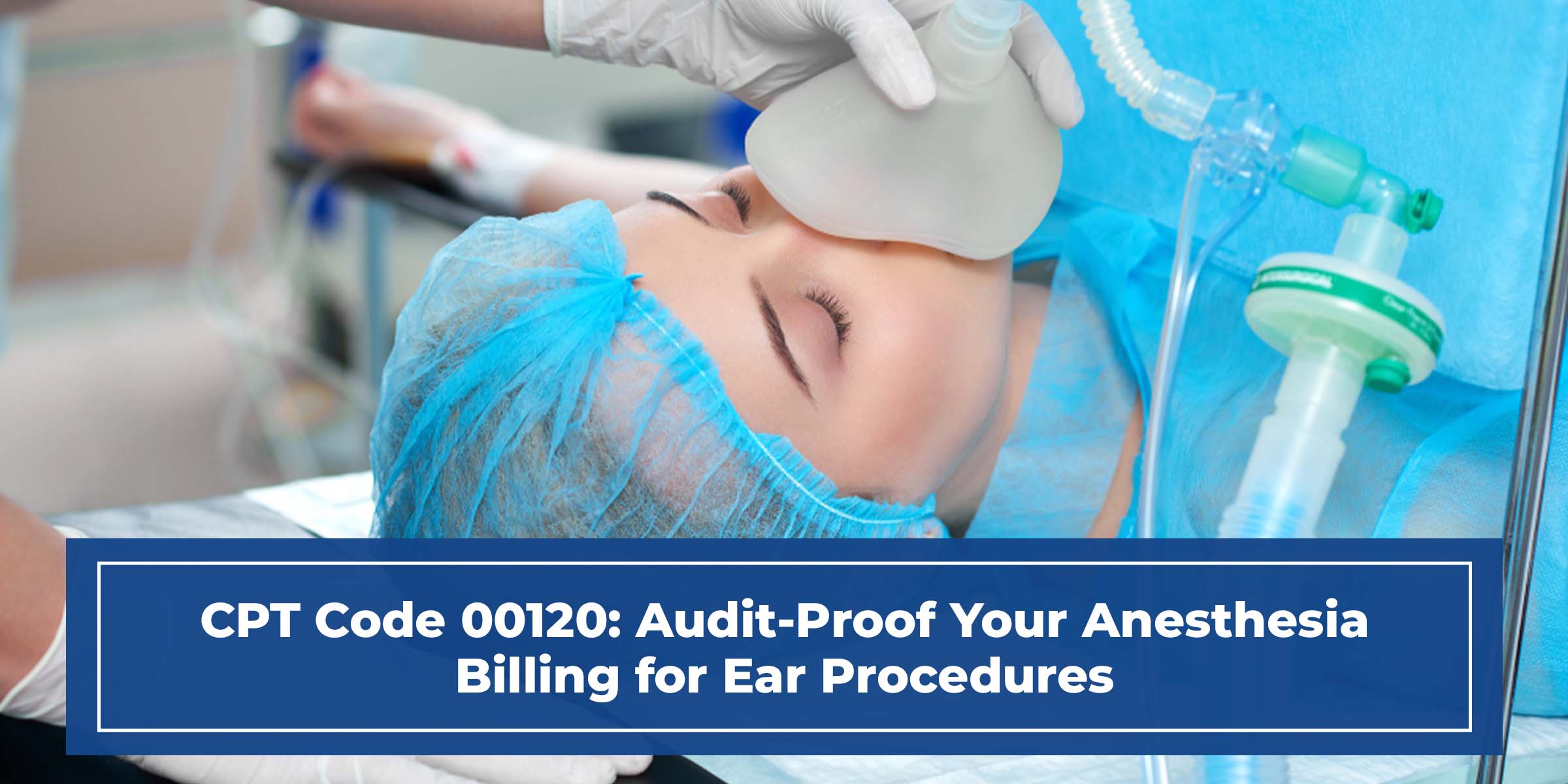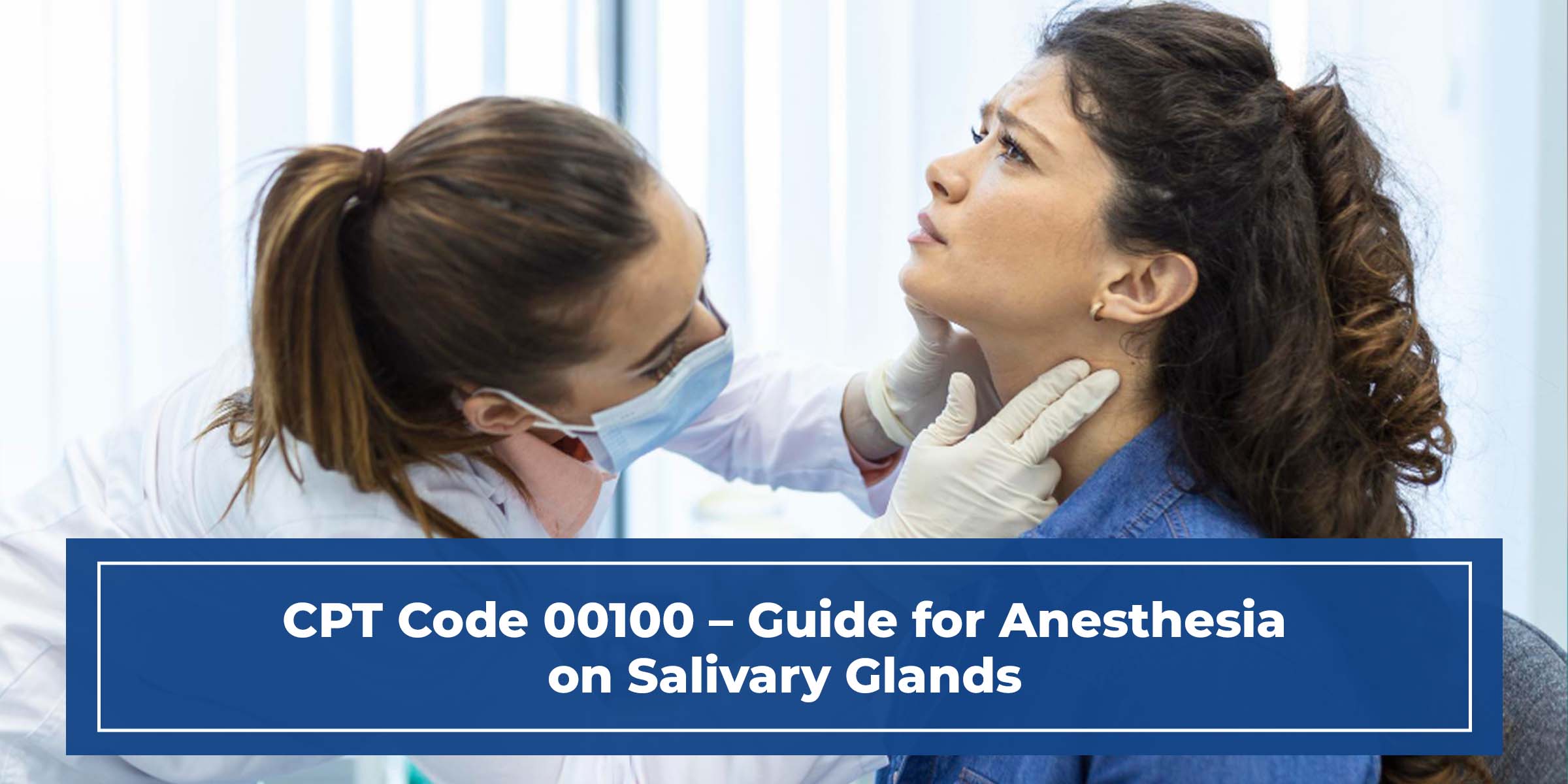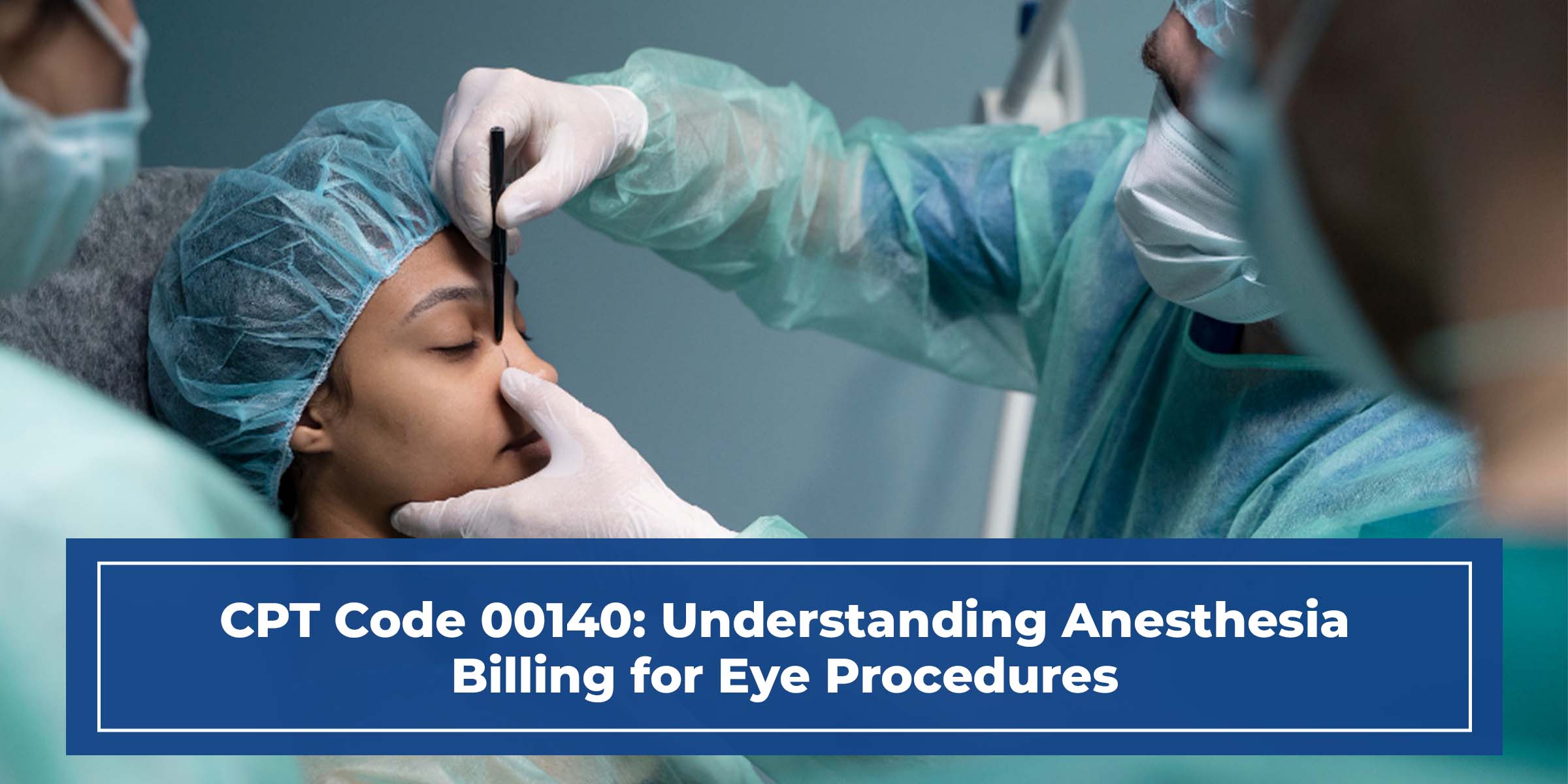In anesthesia billing every detail matters. A single missing modifier or incomplete documentation can turn into denied claims or compliance risks. Among the many anesthesia CPT codes one that coders and billers often struggle with is CPT code 00160. This code covers anesthesia for procedures on the nose and accessory sinuses.
At first glance it looks straightforward but in practice it requires careful handling of time units, modifiers, ICD-10 crosswalks, documentation, payer rules, and denial prevention. Competitor blogs often stop at the definition. This guide takes a 360 degree view so you can handle CPT 00160 with confidence.
What is CPT Code 00160 and When Should You Use It
Definition. CPT 00160 is defined as anesthesia for procedures on the nose and accessory sinuses.
When to use it
- Septoplasty
- Endoscopic sinus surgery
- Nasal polyp removal
- Other nasal or sinus procedures without a more specific anesthesia CPT
When not to use it
If a more specific code exists such as 00162 or 00164 that code should be chosen instead. Correct code selection reduces audit risk and ensures proper reimbursement.
Why Accurate Billing for 00160 Matters in 2025
Anesthesia billing is not based on the surgical CPT code but on a formula:
(Base Units + Time Units + Physical Status Units + Qualifying Circumstance Units) × Conversion Factor = Reimbursement
Base units. Assigned by the ASA Relative Value Guide. Always verify the most current RVG.
Time units. Calculated from anesthesia start to anesthesia stop. Medicare allows tenths. Many commercial payers require whole units.
Physical status units. Added for ASA P3–P5 patients (1, 2, or 3 extra units depending on severity). Medicare does not reimburse them, but many commercial payers do.
Qualifying circumstance units. Added with codes like 99100 (extreme age), 99116 (hypothermia), 99135 (controlled hypotension), or 99140 (emergency). Coverage depends on payer policy.
Conversion factor. Rate per unit. Medicare publishes annually. Commercial payers set it by contract.
This means even small errors in time documentation, base unit assumptions, or missing modifiers can affect revenue. With Medicare and commercial insurers tightening edits in 2025, accuracy is more critical than ever.
Anesthesia Time. Documentation Rules You Cannot Miss
For CPT 00160 claims to be paid, anesthesia time must be documented precisely.
- Start time. When the anesthesiologist or CRNA begins preparing the patient and is continuously present.
- Stop time. When continuous attendance ends and care is transferred.
- Continuous time only. Breaks or interruptions cannot be counted unless continuous presence resumes around the interruption.
Example
Start: 10.05. Stop: 12.14. Total = 129 minutes.
- Medicare converts to 8.6 time units (129 ÷ 15).
- A commercial payer might round to 9 whole units.
Every record must show start and stop times in minutes. Rounded times are a common cause of denials.
Modifiers for CPT 00160. Correct Usage and Denial Risks
CPT 00160 always requires a payment modifier.
Payment modifiers
- AA. Personally performed by anesthesiologist
- AD. Medical supervision of >4 cases
- QK. Medical direction of 2–4 cases
- QY. Medical direction of 1 CRNA by anesthesiologist
- QX. CRNA service with medical direction
- QZ. CRNA service without medical direction
Informational modifiers
- QS. Monitored anesthesia care (MAC)
- G8. MAC for deep or complex procedures
- G9. MAC for patients with severe cardiopulmonary condition
Key rule.
Pricing modifier first. QS or G8 or G9 second.
Example. 00160 QX QS.
Denial risk. Claims deny when QS is missing or when QS is placed first instead of the pricing modifier.
Physical Status and Qualifying Circumstances Explained
ASA Physical Status (P1–P6)
- P1. Healthy patient
- P6. Brain-dead patient for organ donation
Medicare does not pay for extra units tied to physical status. Many commercial insurers do. Always report it for clinical accuracy even if it does not add units.
Qualifying circumstance add-on codes
- Extreme age
- Hypothermia
- Controlled hypotension
- Emergency anesthesia
If payer policy allows these, they add extra units. Always confirm contract terms before billing to avoid overstatement or denial.
ICD-10 Crosswalk. Linking 00160 with the Right Diagnoses
Correct ICD-10 coding shows medical necessity. Common diagnoses that support CPT 00160 include.
- J32.9. Chronic sinusitis unspecified
- J32.0. Chronic maxillary sinusitis
- J34.2. Deviated nasal septum
- J33.9. Nasal polyp unspecified
- J31.0. Chronic rhinitis
Special rule for MAC. If billing MAC with QS, the diagnosis must appear on the LCD list from your local Medicare contractor. If not, the claim will deny even if the code looks correct.
The Documentation Checklist for Clean Claims
Before submitting CPT 00160 claims confirm these are present.
- Anesthesia start and stop times in minutes
- ASA physical status P1–P6
- Correct pricing modifier first
- QS. G8. G9 in second position when MAC applies
- Diagnosis supports medical necessity and LCD list
- Documentation of medical direction steps if QK or QY used
- Transfer of care note
A missing checklist item is the fastest path to denials.
Denials in CPT 00160. Why They Happen and How to Fix Them
Common denial reasons
- Missing QS when MAC provided
- Wrong modifier sequence
- Missing documentation for medical direction
- Claim billed without any payment modifier
- Diagnosis not on LCD list for MAC
- Time rounded or undocumented
Fix strategies
- Add QS and resubmit if payer allows corrections
- Reorder modifiers so pricing comes first
- Document every step of medical direction and resubmit
- Always append AA. QX. QZ. QK. QY. or AD
- Link diagnosis to LCD list and include in claim
- Record exact minutes not rounded times
Payer Policy Insights. Medicare. Medicaid and Commercial Plans
Medicare
- Requires QS for MAC
- Pays time units in tenths
- Does not pay extra for physical status
Medicaid
- Often follows Medicare rules but varies by state
Commercial payers
- UnitedHealthcare. Requires QX or QZ for CRNA billing
- Anthem / Blue. Emphasizes correct MAC use with G8. G9
- Some payers reimburse physical status and qualifying circumstances
Always verify policy manuals and contracts. Never assume payer edits mirror Medicare.
Tools and Templates to Improve CPT 00160 Billing Accuracy
Modifier cheat sheet
First position. pricing modifier
Second position. QS. G8. or G9
Time unit calculator
Input minutes. output tenths for Medicare or whole units for commercial.
MAC eligibility checklist
- Site. nose or sinus
- Diagnosis supports LCD
- Documentation shows continuous attendance
- QS or G8 or G9 appended correctly
ICD-10 quick sheet
Top sinus and nasal ICD-10 codes crosswalked with CPT 00160.
Providing these as downloads builds trust with readers and prevents errors in billing teams.
Case Study. A Real Septoplasty Claim Under 00160
Procedure. Septoplasty under monitored anesthesia care
CPT. 00160
Diagnosis. J34.2. Deviated nasal septum
Time. 120 minutes documented
Provider. CRNA with anesthesiologist medical direction
Claim
- CRNA line. 00160 QX QS
- Anesthesiologist line. 00160 QY
Payment calculation
Base units (from ASA RVG) + 8 time units (Medicare) or 8–9 units (commercial) multiplied by conversion factor.
This case shows how modifier sequencing, ICD-10 linkage, and time unit rules all come together for accurate reimbursement.
Conclusion
CPT code 00160 requires precise handling of modifiers, time units, ICD-10 codes, and payer rules. Even small mistakes can trigger costly denials and compliance issues. This guide gave you a 360° view to approach anesthesia billing with accuracy.
For practices seeking expert help with anesthesia claims, our Anesthesia RCM services provide complete support from modifier accuracy to payer-specific compliance. Reduce denials, streamline documentation, and secure faster reimbursements for procedures billed under CPT 00160.
FAQs
What is CPT code 00160 used for
Anesthesia for procedures on the nose and accessory sinuses when no more specific code applies.
Which modifiers go with 00160 under MAC
A pricing modifier first such as AA. QX. QZ. QK. or QY. then QS. G8 or G9 if required.
Does Medicare pay for physical status with 00160
No. Medicare does not reimburse additional units for P1–P6. Some commercial payers do.
How do you calculate anesthesia time for 00160
Document start and stop times. Divide minutes by 15. Report tenths for Medicare. Round per contract for commercial.Which ICD-10 codes support 00160
Common codes include chronic sinusitis, deviated septum, and nasal polyps. For MAC claims the code must be on the local LCD list.
